Container gardening – tips and ideas for adding greenery to even the tiniest of outdoor spaces
No space? No problem. Container gardening is perfect for tiny outdoor spaces, balconies, courtyards, roof gardens, and more – here's all you need to know to start your own

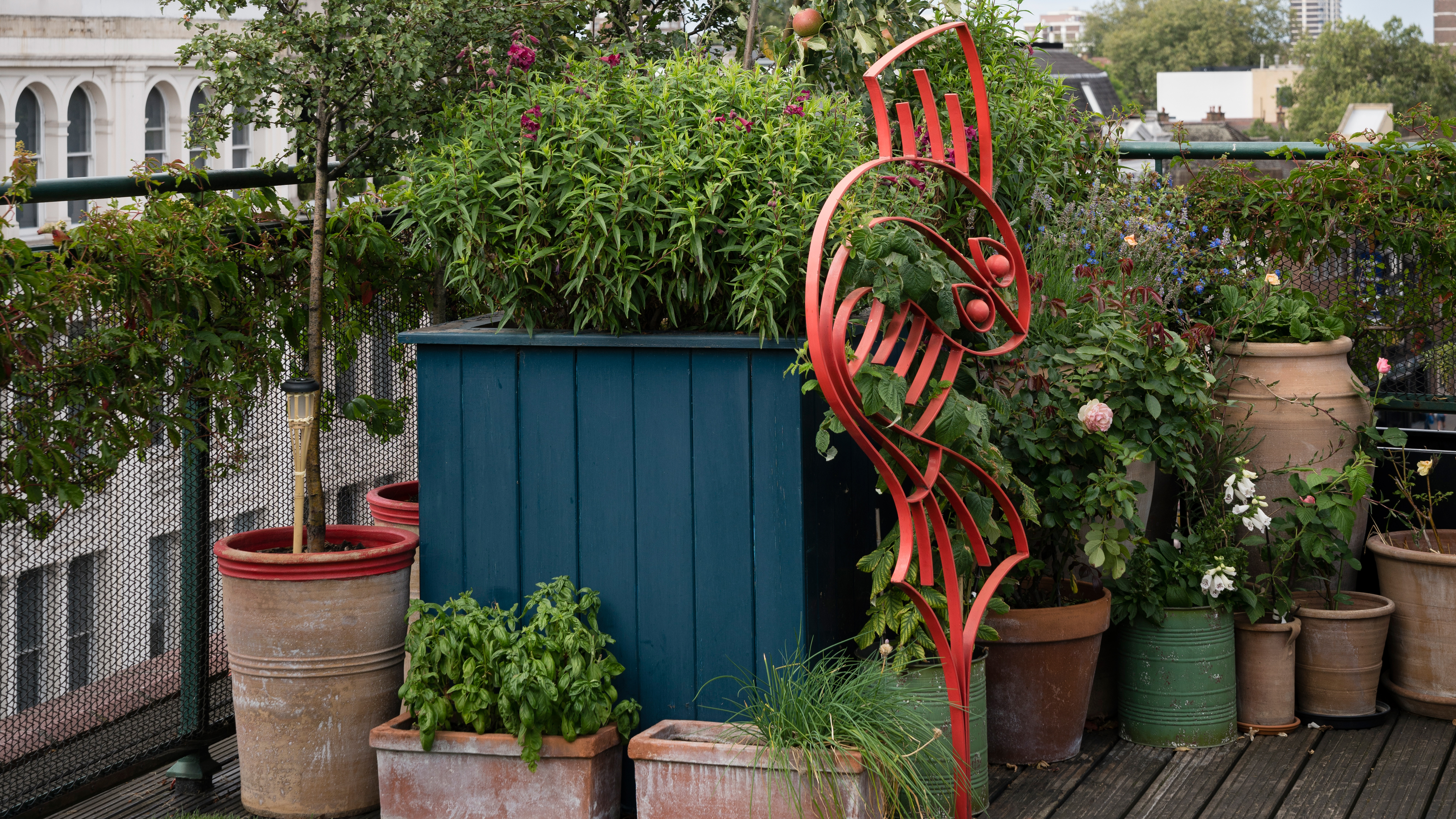
Container gardening is a city dweller's dream. No matter how small your garden/front yard/balcony/terrace/patch of pavement in front of your apartment, a container garden can add texture, color, vibrancy, and gorgeous scents too. They can be designed to add privacy too, plus are totally flexible so you can move them around, replant them and create new looks with every season. Not to mention they are fabulous for urban wildlife.
Versatility is also a huge benefit of creating a container garden, you can create something to suit your own personal style. Whether you want to create a traditional English garden on a miniature scale with fruit trees and roses and hollyhocks or after something more contemporary with ferns and palms.
Now, if you are not the greenest of fingered, container gardens are great for beginners and we've brought together plenty of lovely garden ideas to get you inspired, plus asked the container garden experts for their top tips so you can get it right.
What can you grown in a container garden?
You'd be surprised how many plants, flowers, and vegetables can happily live in the right-sized pot, positioned in the right spot.
As Stina Hasan, urban gardener and founder of The Hackney Gardener explains, 'Most things do well in pots as long as you choose the right containers and look after them properly. Things like trees and roses for example need large, deep pots for their root systems to fit. I would give anything a go – perennials, annual flowers, vegetables, potatoes – you name it!'
Interior designers and landscape experts, Manscapers add, 'When it comes to selecting plants, consider varieties suitable and hardy enough for container gardening and favor those with height, texture, color, and draping. Aim for three out of those four variables to create a nice-looking vignette. Don’t skip the “under planting.” These smaller plants or vines are planted at the base of a large or medium pot, beneath a larger bigger tree or shrub. You can achieve a draping effect with creeping Jenny, or add color or texture with some in-season annuals such as impatiens or geraniums.'
'Almost any plant including vegetables, flowers, herbs, shrubs, or trees will grow successfully in a container. Just be sure to select plants that are appropriate for the climate zone you live in and the amount of sun or shade the container will receive. Part of the beauty of planting in containers is you can change them out every year or you can design permanent planting containers. Just keep in mind that plants are more exposed to the temperatures because they are not planted in ground and some non-hardy plants might need to be moved to a warmer location in the winter months.'
The Livingetc newsletters are your inside source for what’s shaping interiors now - and what’s next. Discover trend forecasts, smart style ideas, and curated shopping inspiration that brings design to life. Subscribe today and stay ahead of the curve.
So whatever look you want to create with your container garden it's doable with a little know-how...
1. Blur the edges of a small courtyard garden with potted plants
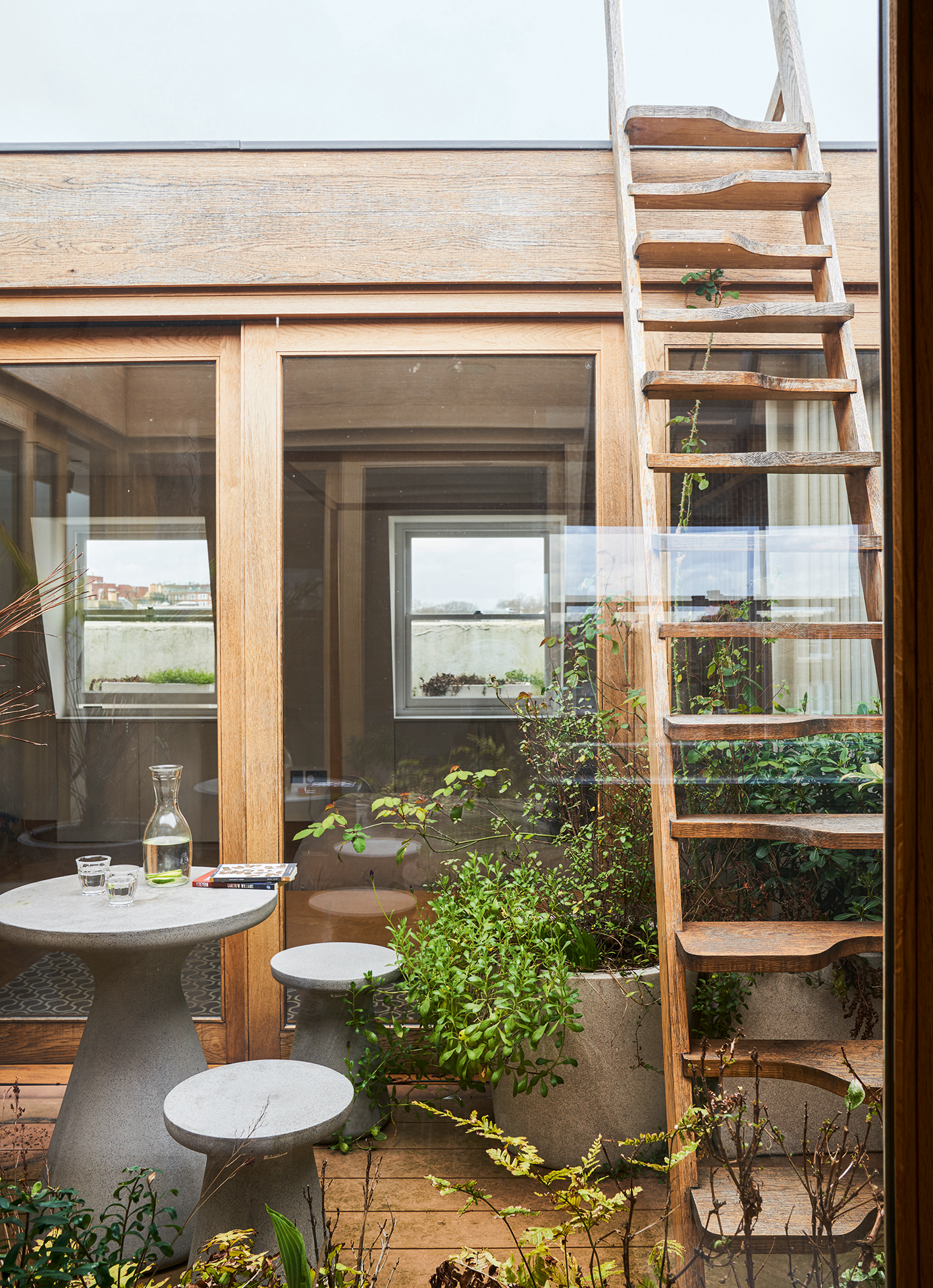
This is a really easy trick for making a small garden look bigger – create 'borders' around the edges of a small courtyard garden or balcony so the edges of the space become less apparent. Greenery acts to blur the boundaries of the outdoor space, adding texture and depth that can allude to a larger space.
Now, we don't mean line your space with uniform terracotta pots filled with teeny tiny plants, oh no – contrary to popular belief, go big in a small space. Think big leafy plants like ferns, tree ferns and hostas, and even trees that cope in pots like olive trees and citrus. You want to fill in any obvious gaps with plants that appear to spill over the edges of the pots like petunias, ivy, and trailing pelargoniums. The idea is to create a thick enough container garden so you don't really notice the proportions of the space.
For an evergreen idea, familiarize yourself with the best shrubs for containers as a leafier alternative to flowers.
2. Take the thriller, filler and spiller approach
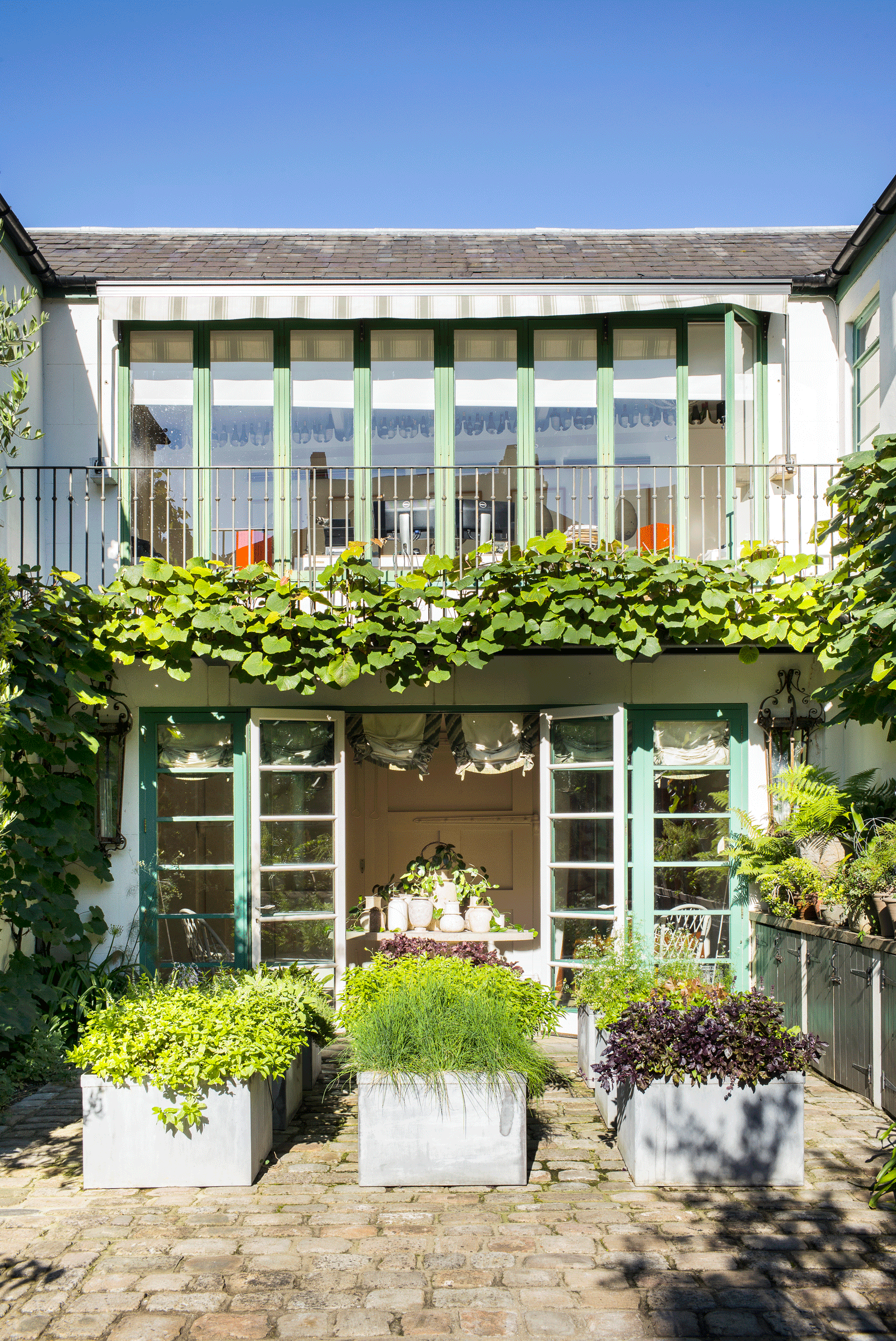
The thriller, filler and spiller approach is a tried and tested method when it comes to container gardening. It's all about creating depth.
Sarah Raven explains, 'When planning what to grow in containers, first, I think about color. I usually select two plants from the same color palette and one from another for a little contrast.'
'Next, I think about form and scale. I’ll choose something eye-catching which I call my Thriller, like Dahlia ‘Totally Tangerine’, then I’ll add a quieter sidekick often in the same color as my Filler, Panicum ‘Sparkling Fountain’ is tonally a similar color to ‘Totally Tangerine’. Then I’ll add a Pillar to add height and scale, here I’d go for Salvia ‘Amistad’ with beautiful blue petals, as if cut from silk, to contrast against the orange of the dahlia. Finally, sometimes I’ll add a spiller, a trailer to soften the edge of the pot, especially if it is for a table.'
3. Create moveable borders full of interest

One of the huge advantages of a container garden is that they are moveable so you can easily change the look and layout of your space (it goes without saying only move pots if you can do so safely). Unlike border ideas that dig down, pots and containers allow you to create changeable borders that can be flexible – changing shape, color, and texture with the season. Ideal if you want the look of a border but digging down isn't an option, say on a roof garden or a balcony. This approach is also great for landscaping a patio without having to pull up any patio slabs.
The key to recreating the look of a border using containers is plenty of depth and different textures. You almost don't want to notice each plant is in a separate container. Approach as you when planning a border, start with the largest plants and trees – choose two of three that will noticeably stand above the rest of the plants so the eye has somewhere to focus. Then work outwards from there choosing small containers to fill in the gaps.
Manscapers advise 'To compose an arrangement of garden pots, work from largest to smallest. Set a small tree (appropriate to your climate, of course) planted in a large pot as the anchor, and then surround it with smaller accent pots in graduated sizes.'
'We typically cluster pots in three sizes—small, medium, and large—and coordinate all of them within a scheme. They don’t have to match, but should complement each other by material, color palette, or texture.'
4. Mix and match your containers
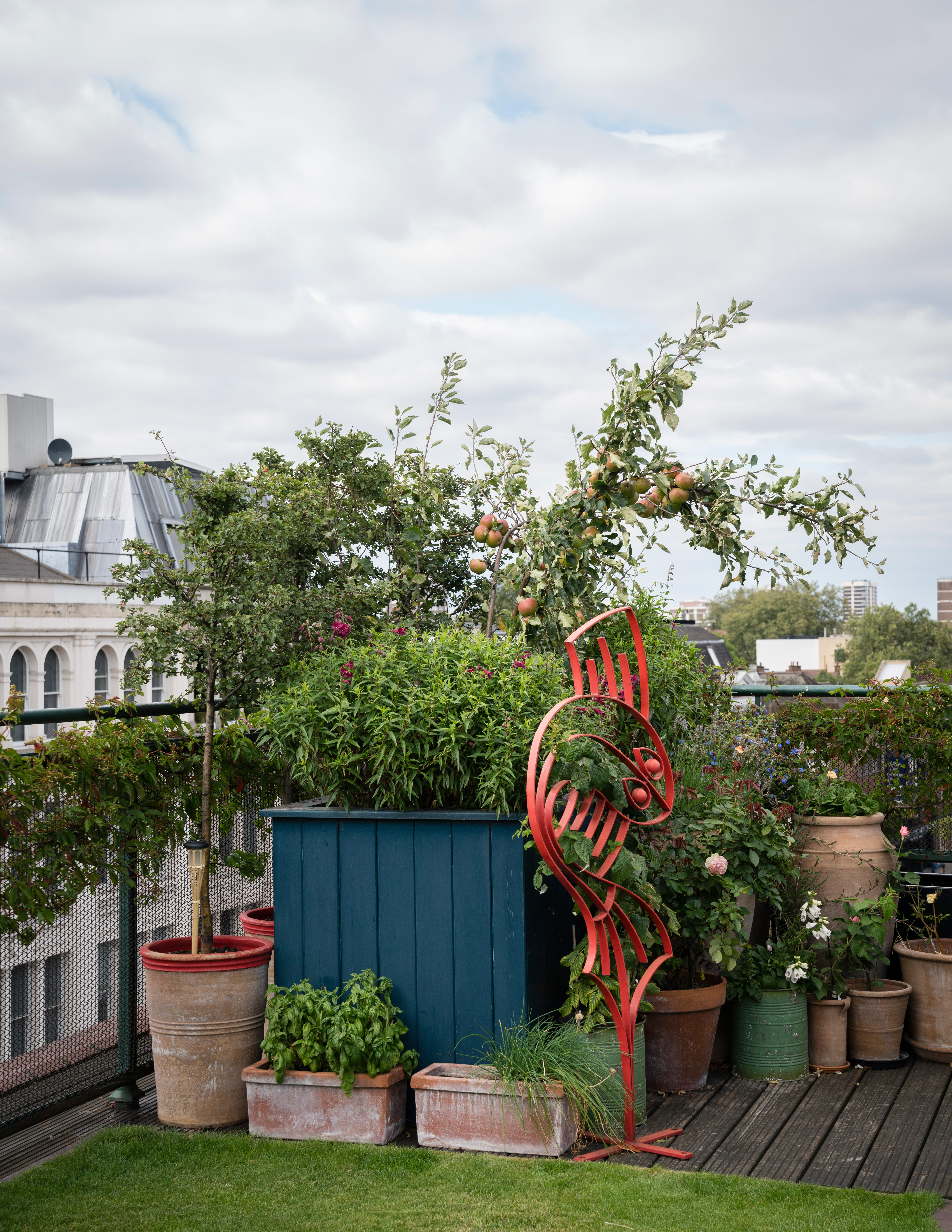
The best container garden ideas are ones that use a whole myriad of different size, shapes, and materials of container. This mix is also what helps give the container garden depth and not feel like a bunch of plants in uniform pots but a beautiful and intriguing display that looks natural.
Approach it as you would a room – it's this mismatch of styles and variety of shapes that gives a room personality and the same goes for a container garden. Choose sleek and contemporary pots and mix them with traditional terracotta designs. And combine tall and slime shapes with large round designs and fill in any gaps with an array of tiny pots. This rooftop garden is the perfect example.
Take home tip: avoid plastic containers as they won't age in the same way are natural materials and will stand out amongst the foliage. Wood, terracotta, and wicker all make for nice containers.
5. Allude to height
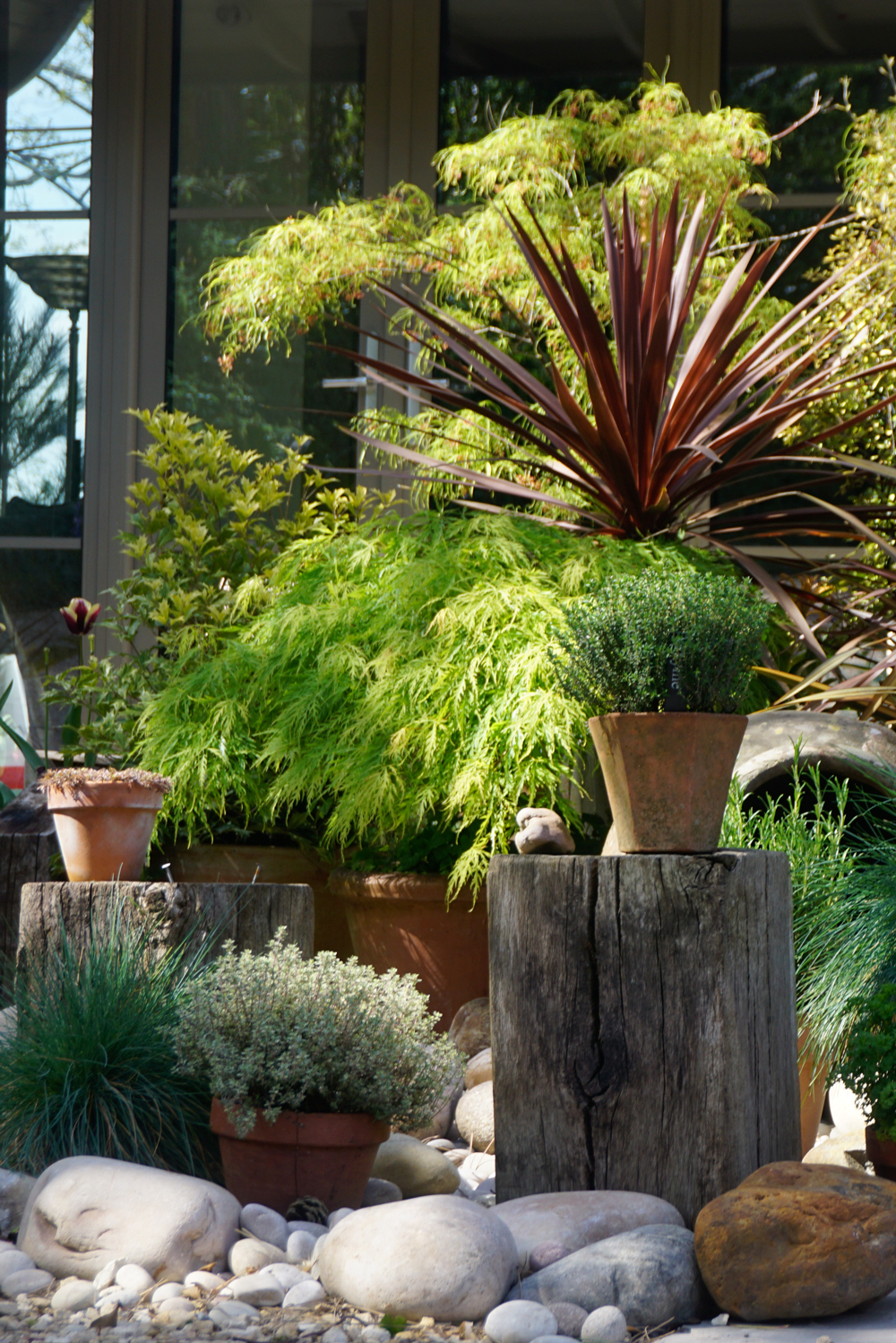
There are plenty of trees that will grow quite happily in containers – olives, acres, fruit trees, and citrus trees – for example, and give the space can grow to impressive heights. However, a low maintenance garden idea to create the allusion of height within a container garden is to cheat a bit and use a stand to give that all-important variation.
'For an interesting container garden, I recommend giving pots a stage, placing them on tables or in a plant stand – this lifts the pot, or collection of pots, to a more viewable level and works really well.' suggests Sarah Raven.
'With the right plants in them, a good selection of pots in different shapes and sizes are an essential part of my garden. I always think of containers like our garden’s party outfit. The whole place looks fine without the dressing up, but it’s enhanced by the extra effort.'
We love this idea of using tree stumps to take smaller plants up off the ground, while still maintaining a very natural look. This is such a lovely mix of plants for a container garden too. There might not be any bold stand of out colors but the green scheme and the warmth from the Cordyline australis feels chic and contemporary. Recreate the look with a mix of acre trees, grasses, and ferns.
Note the use of the stones in between the pots too, adding yet more textures and linking the plants together so they fill like one display rather than separate pots.
6. Zone a patio with a container garden

We may have given off the impression we aren't the biggest fans of lots of small, uniform pots, but this stylish patio idea is proving us wrong – the look can work and feel chic and contemporary rather than fussy.
We think the look relies on what you plant. This collection of succulents adds a cool, exotic vibe that mirrors the contemporary furniture. And the plants cleverly zones off this space too, making the seating area feel separate from the rest of the garden.
Just be aware that while succulents make for great container garden plants, they don't like a lot of water and need heat, so if you live in cooler climes be sure to bring them indoors or into a greenhouse during the winter months.
7. Blend furniture into a garden
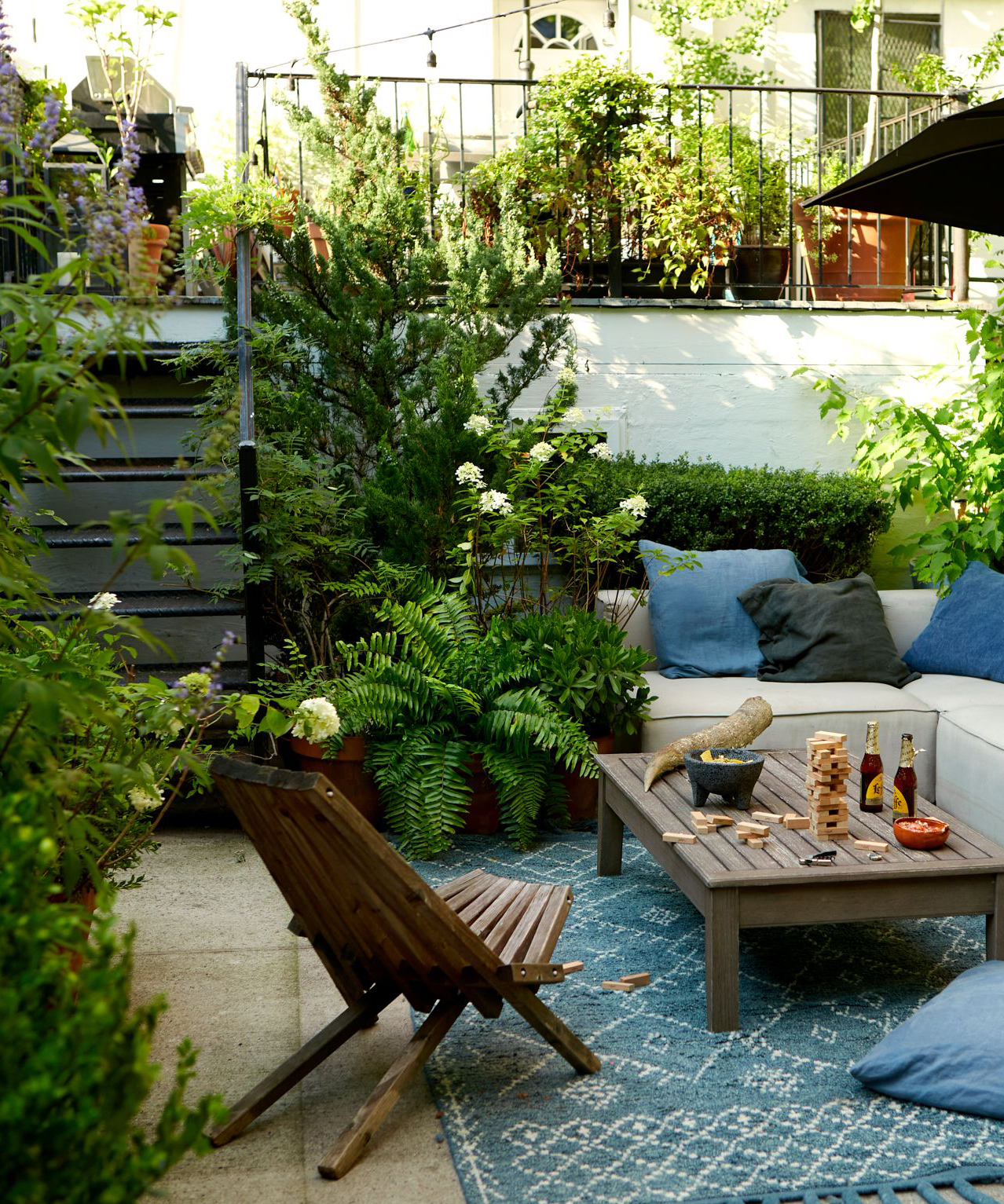
Outdoor living rooms have been such a huge garden trend over the last few years. No longer is it enough to have a dining table you drag out every summer for alfresco dinners, no we all want to recreate our living rooms outdoors, sofas, armchairs, rugs, coffee tables, the lots. And actually, pots and containers can help these traditionally indoors pieces of furniture fit seamlessly into the outdoors.
Make your outdoor furniture look like it's always been there are part of the landscape by surrounding it with potted plants. Gather smaller plants around the edges of sofas, as can be seen here, it softens the corners and blends it seamlessly into the surrounding greenery.
8. Add a chic tropical feel with succulents and cacti
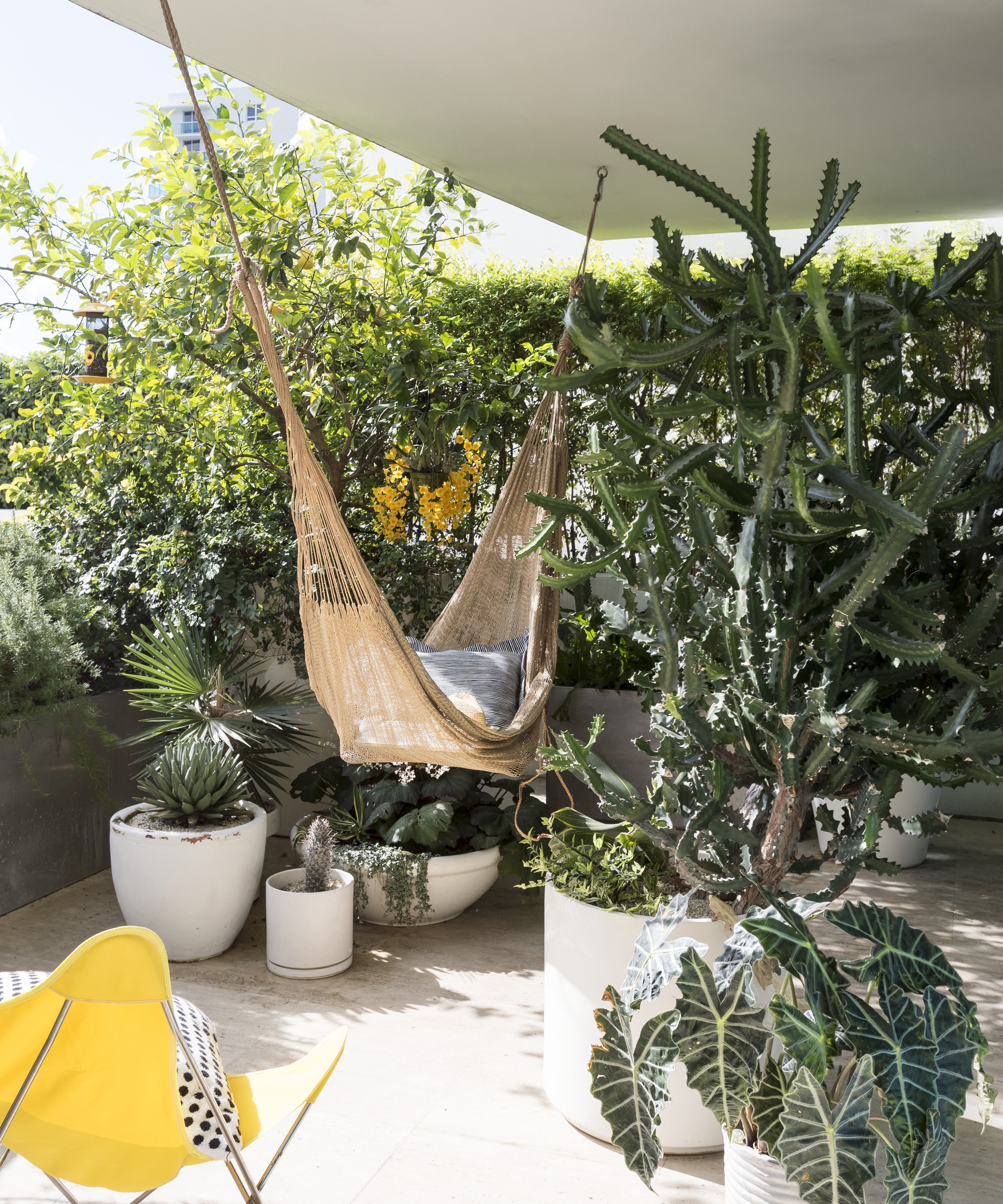
Does it get any cooler than sleek white pots filled with towering cacti? If you like a minimalist, contemporary look, cacti and succulents will instantly give a container garden that cool, Cali vibe. Just do be aware that cacti like a hot, dry environment so if you are a Cali look, but lack the Cali climate, might we suggest you take your cactus garden indoors.
If your climate however suits these sun-loving species, all you need to consider is the right container. Your choice will need good drainage, so holes in the bottom and ideally made from a porous material that allows moisture to evaporate. The right size will depend on the size of your plant, but bear in mind cacti don't have deep roots so won't need a very deep container.
If you like this more exotic urban garden look but temperatures just won't allow for a mini dessert on your patio, instead opt for tree ferns, bamboo, hostas, or even hardy palms like Chasun palm. You'll still get that lush green, jungle-like feel but they'll be able to handle rain and slightly cooler temperatures.
9. Choose large containers to create privacy
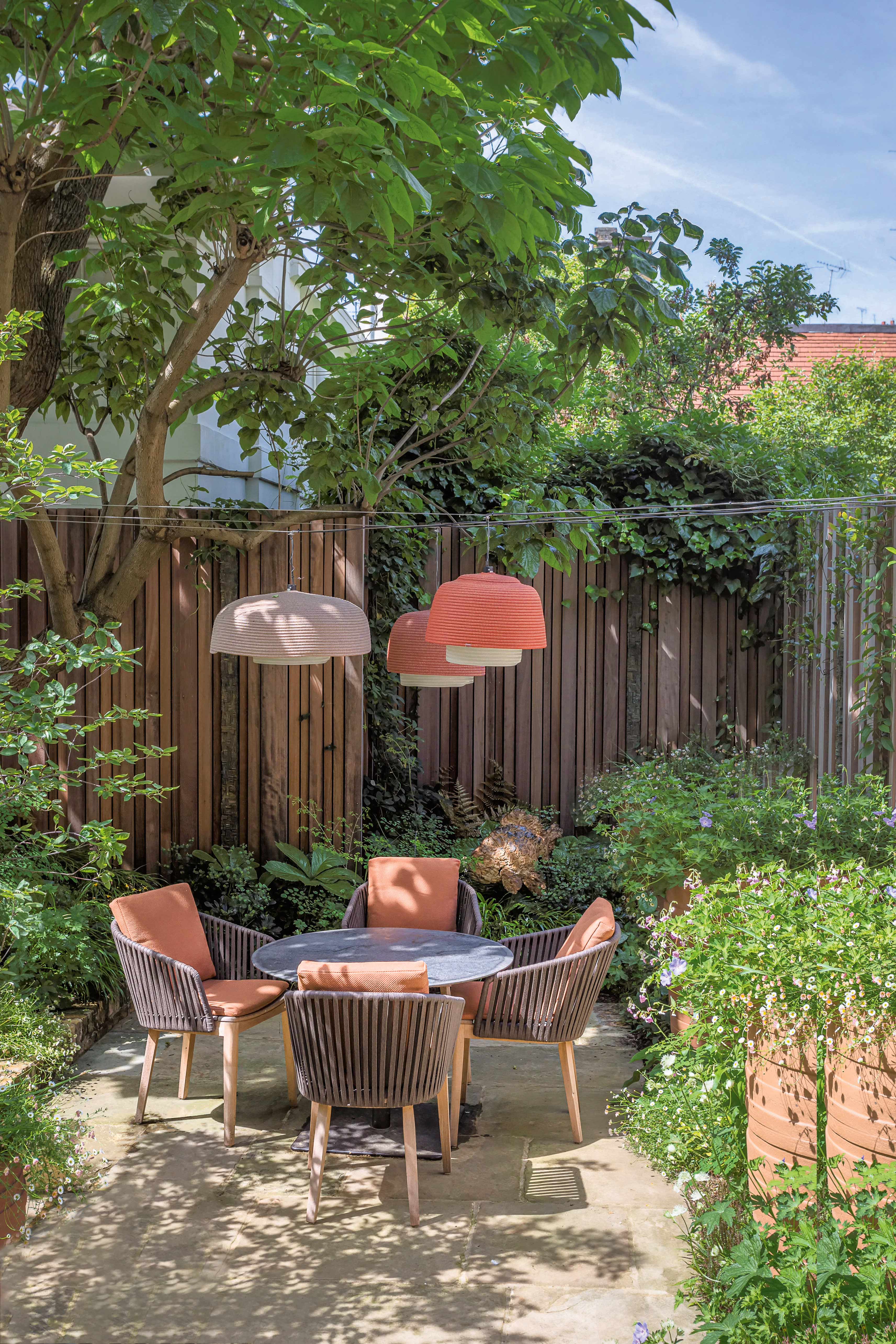
Container gardens can also be a way to add privacy to garden, courtyard, or balcony. Use them almost to create a screen that can will zone part of your garden so it feels more secluded. Bamboo is perfect for this as it grows tall fast, as are ornamental grasses like miscanthus or pampas grass.
You could also opt for taller containers to act as a fence and then soften them by filling them with plants and flowers that delicately flow over the edges as has been used here in this perfectly formed small garden.
What container should you choose for you plants?
The best containers will depend on the plants you chose. You'll need to consider, size, shape, and material based on want you intend to plant. Stina's top piece of advice is 'Make sure to get the right size. Better to buy one large pot than lots of small ones. Larger pots hold water and nutrients better so plants are more likely to thrive.'
When deciding on the best size, look at your plant's root system – how large and deep does it grow and at what speed? You don't want to be replanting every month so ensure your choice of container allows plenty of room for growth. Also, consider where the planter will be. Do you want to be able to easily move it? Is it on a balcony where weight could be an issue?
Material can make a difference too. Terracotta is a popular choice, it's porous so great for plants that don't like to soak, however they break easily and can crack with changes in temperature. Wooden planters can be a good choice too, not only do they look lovely and can easily blend into your display, they are sturdy and perfect for protecting plants from cooler temperatures. Concrete containers are also a good choice, however, they can get heavy.
'You can get really creative with non-traditional containers. We have built gardens out of cinder blocks which can give a really neat height stacked with different plants draping. There is also Wooly Pockets which are made from fabric and perfect for vertical planting.' explain Manscapers.
Sarah Raven suggests that, 'Almost anything can become a container for a plant – the key thing is drainage. All containers need drainage holes or they quickly become swamps and rot plants.'
'My colleague Arthur Parkinson who, gardens almost entirely in containers, uses galvanized dust bins, dolly tubs, even old bathtubs! For the kitchen garden, grow bags have become increasingly popular to grow all sorts of veg into, even if all you have is a small patio to garden from. We’ve recently started selling sustainable planters made out of hemp and we’ve got a mini wooden raised bed that’s perfect for balconies too.'
How do you care for a container garden?
Caring for a container garden can be relatively low maintenance but it does depend on what you have chosen to plant. They'll need to be regularly monitored to ensure they don't dry out however you don't want to overwater your plants either as you don't want them sitting in wet compost.
'All pots will need feeding and watering and some plants will need this more than others.' says Sarah Raven. 'We love growing dahlias in pots but they are hungry, thirsty, high-maintenance plants. In comparison, herbs like rosemary and oregano practically thrive on neglect. Drought-tolerant plants like Echium ‘Blue Bedder’ are similarly easy to look after in pots. Permanent perennials and shrubs are great for keeping both cost and maintenance down. I’d recommend a dwarf buddleia like ‘Buzz Lavender’ which I have in a long tom with Pelargonium ‘Attar of Roses’ and a Heliotrope ‘Reva’ for extra scent and color.'
Repotting is also part of container garden care, to avoid any of your plants becoming root-bound. So keep an eye on how much space the roots are taking up within the pot.
What are the disadvantages of a container garden?
'You really have to keep up with the watering in warm weather.' advises Stina. 'Pots dry out much quicker than the ground so in high summer a daily watering ritual is highly recommended. This might sound like a chore but it can actually be very relaxing to spend 15 minutes every evening looking after your plants - perfect for winding down after a day at work. If you can't commit to that, consider using an irrigation system.'

Formerly the Digital Editor of Livingetc, Hebe is currently the Head of Interiors at sister site Homes & Gardens; she has a background in lifestyle and interior journalism and a passion for renovating small spaces. You'll usually find her attempting DIY, whether it's spray painting her whole kitchen, don't try that at home, or ever-changing the wallpaper in her entryway. She loves being able to help others make decisions when decorating their own homes. A couple of years ago she moved from renting to owning her first teeny tiny Edwardian flat in London with her whippet Willow (who yes she chose to match her interiors...) and is already on the lookout for her next project.